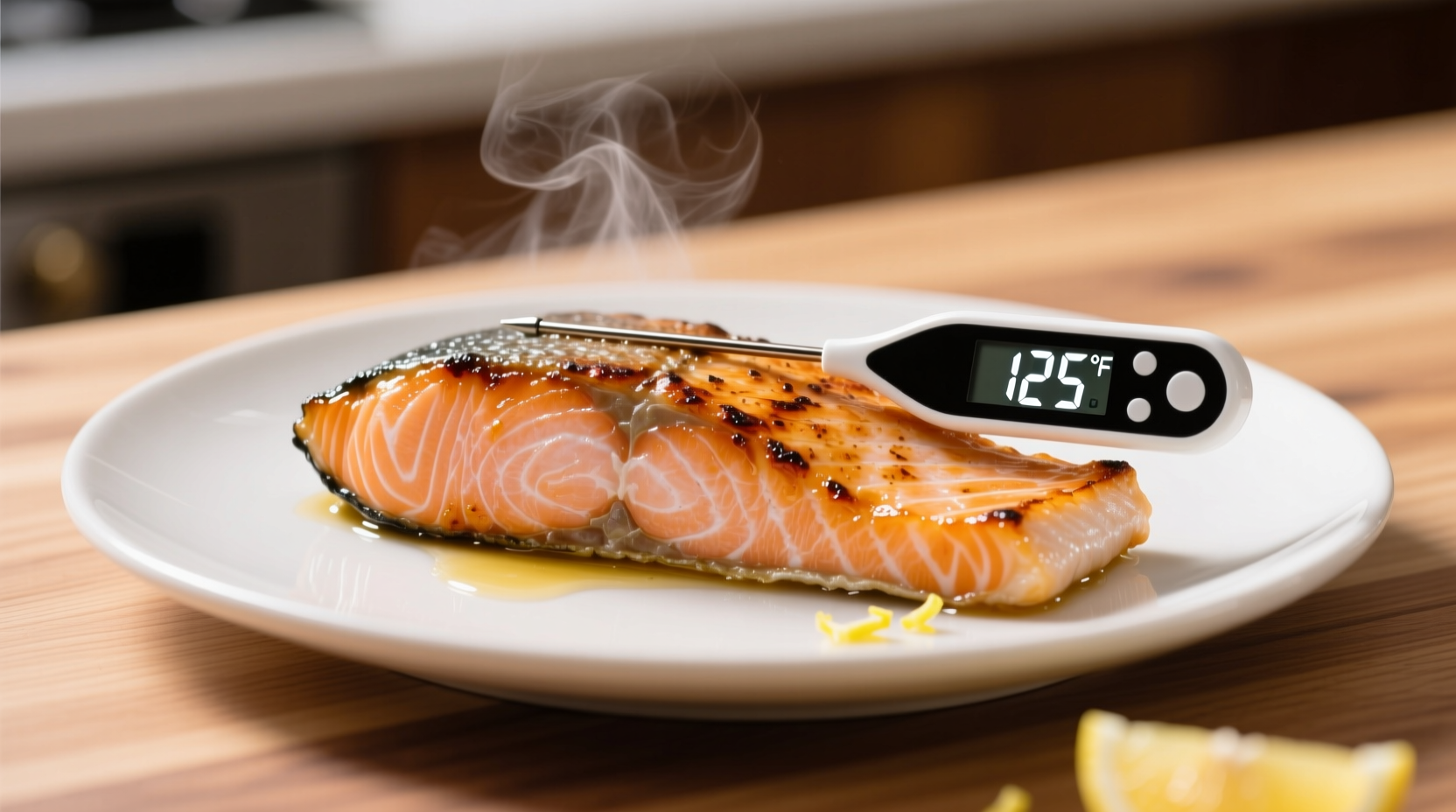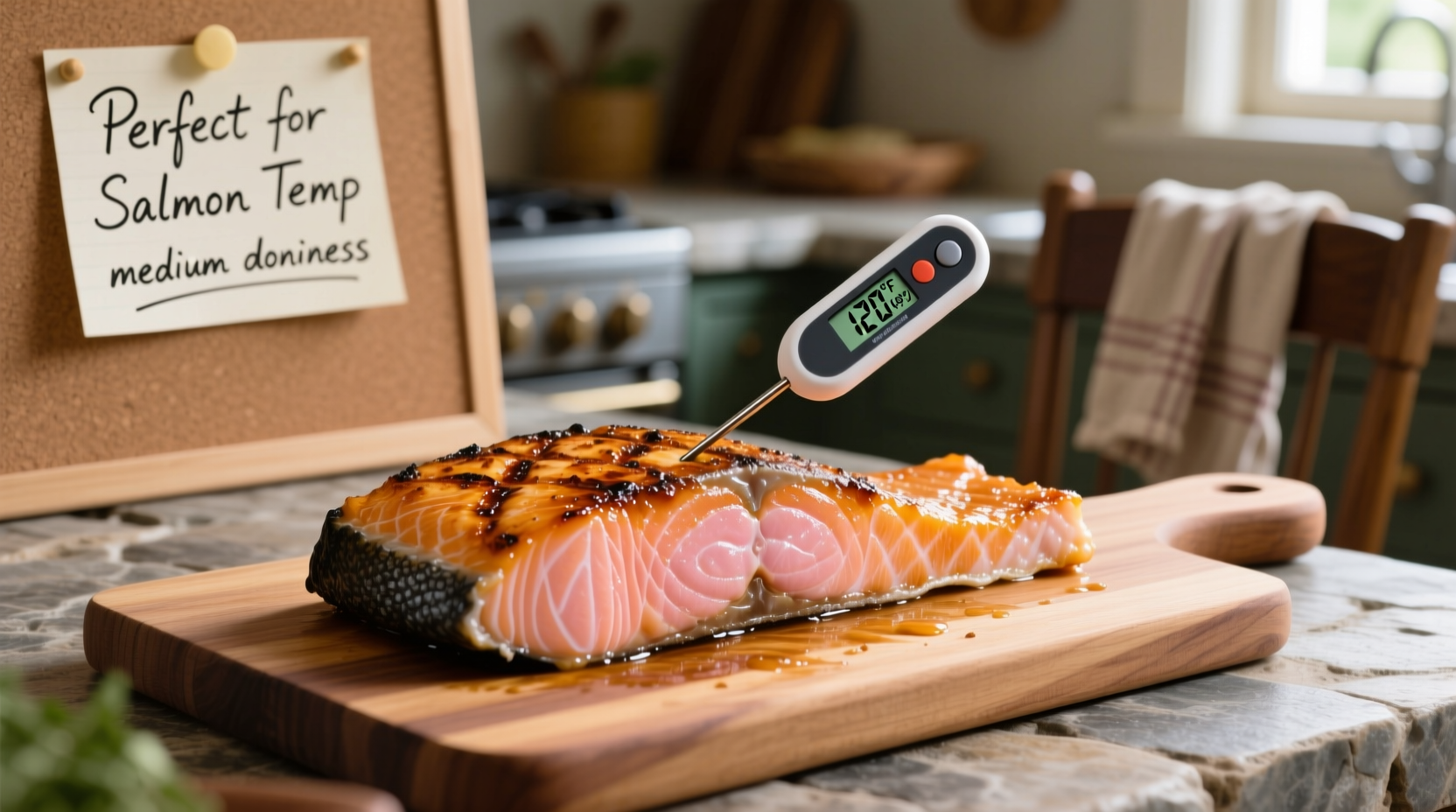Planning Your Perfect Salmon Cooking Experience
Understanding the right temperature for salmon isn't just about numbers—it's about creating a cooking experience that delivers restaurant-quality results at home. Many home cooks make the mistake of following the USDA's 145°F recommendation without understanding the science behind salmon's delicate protein structure. When salmon reaches 145°F, its muscle fibers contract significantly, squeezing out moisture and resulting in dry, chalky fish.
The FDA Food Code actually states that fish should be cooked to "145°F or until the flesh is opaque and flakes easily with a fork." This "or" clause is crucial—visual doneness indicators matter as much as temperature readings. For salmon specifically, the ideal texture occurs well before reaching 145°F.
Why Temperature Precision Matters for Salmon
Salmon's high fat content makes it more forgiving than lean fish, but temperature accuracy remains critical. Unlike chicken or pork, salmon doesn't require extreme temperatures to eliminate pathogens because it's typically flash-frozen before sale, killing parasites. The FDA Food Code specifies that fish intended for raw consumption (like sushi) must be frozen at -4°F (-20°C) for 7 days or -31°F (-35°C) for 15 hours to destroy parasites.
When cooking salmon, the critical temperature range to understand is 120-140°F (49-60°C). Within this range:
- 120°F (49°C): Translucent center, very rare
- 125°F (52°C): Medium-rare, optimal for most palates
- 130°F (54°C): Medium, slightly more firm
- 135°F (57°C): Medium-well, beginning to lose moisture
- 140°F+ (60°C+): Well-done, often dry and flaky
| Cooking Method | Recommended Pull Temperature | Resting Time | Final Temperature |
|---|---|---|---|
| Oven Roasting | 125-130°F (52-54°C) | 5-7 minutes | 130-135°F (54-57°C) |
| Pan-Seared | 120-125°F (49-52°C) | 3-5 minutes | 125-130°F (52-54°C) |
| Grilling | 125°F (52°C) | 5 minutes | 130°F (54°C) |
| Poaching | 120°F (49°C) | 2-3 minutes | 125°F (52°C) |
| Smoking | 125°F (52°C) | 5 minutes | 130°F (54°C) |
Essential Tools for Temperature Accuracy
An instant-read thermometer is non-negotiable for perfect salmon. The Thermapen ONE, recommended by America's Test Kitchen, provides readings in 2-3 seconds with ±0.5°F accuracy. Before using any thermometer, calibrate it using the ice water method (should read 32°F/0°C) or boiling water method (212°F/100°C at sea level).
When measuring temperature:
- Insert the probe into the thickest part of the fillet
- Avoid touching the cooking surface or bone
- Take multiple readings if the fillet has uneven thickness
- Check temperature 5-10 minutes before expected doneness

Cooking Methods and Temperature Adjustments
Each cooking method requires slight temperature adjustments due to different heat transfer rates:
Oven Roasting (Best for Even Thickness)
Preheat oven to 375-400°F (190-204°C). Roast until internal temperature reaches 125-130°F. The high ambient heat creates significant carryover cooking—up to 10°F during resting. For thicker cuts (1.5+ inches), reduce oven temperature to 325°F (163°C) for more even cooking.
Pan-Seared (Ideal for Crispy Skin)
Start skin-side down in a 400°F (204°C) skillet. The intense direct heat means less carryover cooking—only 5°F. Remove at 120-125°F for medium-rare. The Cook's Country testing shows that finishing in a 350°F oven after searing produces the most consistent results.
Grilling (Perfect for Smoky Flavor)
Use two-zone grilling with direct and indirect heat. Sear over direct heat, then move to indirect until reaching 125°F. The open flame environment creates variable heat, requiring more frequent temperature checks. Resting time should be slightly longer (5+ minutes) due to the high initial heat exposure.
The Critical Resting Phase
Resting isn't optional—it's when carryover cooking completes the process. During resting:
- Temperature rises 5-10°F depending on cooking method
- Proteins relax, redistributing juices throughout the fillet
- Surface moisture evaporates, improving texture
Cover loosely with foil to retain heat without steaming the fish. For every inch of thickness, rest for 3-5 minutes. Never skip this step—cutting into salmon immediately after cooking releases precious juices onto your cutting board.
Visual Doneness Indicators When Thermometer Isn't Available
If you don't have a thermometer, use these visual cues:
- Color change: Translucent pink becomes opaque but still slightly glossy
- Flakiness test: Gently press with fork—it should flake with slight resistance
- Texture: Should feel springy, not mushy or hard
- Surface moisture: Small beads of albumin (white protein) appear but aren't excessive
Remember that wild salmon typically has a deeper color and firmer texture than farmed, requiring slightly lower final temperatures. The Oregon State University Seafood Extension notes that wild salmon contains less fat, making it more prone to drying out at higher temperatures.
Avoiding Common Temperature Mistakes
Even with a thermometer, these errors frequently occur:
Mistake: Checking Temperature Too Early
Opening the oven or lifting the lid repeatedly causes temperature fluctuations. Check only during the last third of estimated cooking time.
Mistake: Ignoring Fillet Thickness
A 1-inch fillet needs about 8-10 minutes at 400°F, while a 2-inch steak requires 15-18 minutes. The University of Maine Cooperative Extension confirms that cooking time increases exponentially with thickness, not linearly.
Mistake: Not Accounting for Starting Temperature
Cold salmon from the refrigerator needs 2-3 minutes longer than room-temperature fish. Always let salmon sit at room temperature for 15-20 minutes before cooking for more even results.
Temperature Troubleshooting Guide
Problem: Salmon is dry despite hitting target temperature
Solution: You likely removed it from heat too late. Pull at 120-125°F for medium-rare, not 130°F.
Problem: Center remains translucent after reaching target temperature
Solution: Your thermometer may be miscalibrated or placed incorrectly. Verify with ice water test and check multiple spots.
Problem: Uneven cooking with overcooked edges
Solution: Your heat source is too intense. Reduce temperature and increase cooking time for more even heat penetration.











 浙公网安备
33010002000092号
浙公网安备
33010002000092号 浙B2-20120091-4
浙B2-20120091-4